Cattle Shed Lighting: Best Led Lights for Cattle Sheds
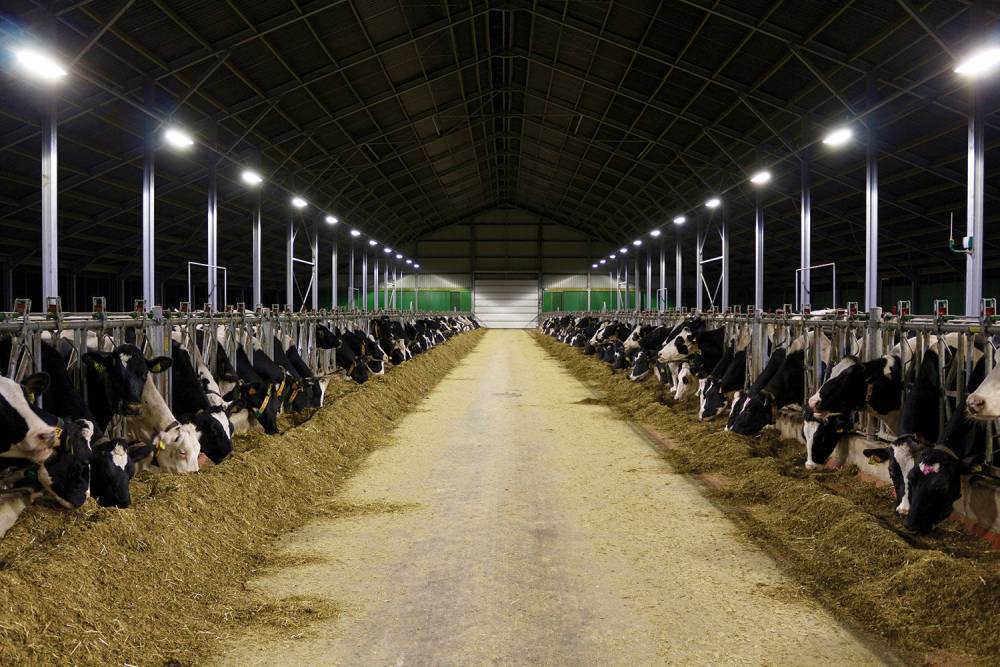
Directory:
1. Current state of lighting in cattle sheds
2. Analysis of Lighting Environment Requirements for Breeding
3. Intelligent Lighting System Design for cattle sheds
4. cattle shed Lighting Control Parameter Configuration
5. best led lights for cattle sheds
Lighting in cattle sheds plays a crucial role in aquaculture, impacting the lactation performance and overall health of dairy cows. A well-designed lighting environment can enhance both milk production and quality, while inadequate lighting can negatively affect dairy cows' productivity and harm their health and eyesight.
This study developed an intelligent lighting system for cattle sheds, tailored to the growth, production, and health requirements of dairy cows. The system is capable of real-time monitoring, displaying, and adjusting lighting parameters based on the conditions within the cattle shed. It can modify the duration and intensity of light according to changes in the environment, ensuring optimal lighting for the growth, productivity, and health of the cows. Additionally, to align the lighting cycle, intensity, and comfort with the actual needs of dairy cows, optimal control parameters for lighting duration and intensity were established through testing and data analysis, demonstrating that the intelligent lighting system positively influences milk production.
1. Current state of lighting in cattle sheds
1.1 Poor lighting quality in farming
cattle sheds typically feature an enclosed design that relies on natural light during the day and artificial lighting at night. However, natural light varies with seasons and weather, making it unreliable for dairy farming. Since dairy cows are ruminants that often eat and ruminate at night, they require adequate lighting during these hours. Unfortunately, most nighttime lighting in dairy farms is designed primarily for the convenience of staff, neglecting the nighttime activity needs of the cows and the effects of light on their physiological hormones. Currently, the combination of natural and artificial lighting in large-scale dairy farms in Yunnan Province lacks scientific rigor, leading to a subpar lighting environment that fails to meet the technical standards for large-scale dairy farming.
1.2 Lighting management in cattle sheds is outdated
The lighting systems in cattle sheds primarily rely on traditional power distribution designs, which are manually controlled. There are no sensors for light intensity or color temperature installed in these facilities. As a result, the operation of the lights depends solely on the staff's experience or visual judgment, leading to inconsistent lighting cycles that significantly affect dairy cows' feed intake, milk production, and hormonal balance. Additionally, standard lighting fixtures are typically used, with brightness and color chosen based on the nighttime needs of the workers rather than the cows. Since these ordinary lamps have fixed light intensity and color temperature that cannot be adjusted automatically, they fail to meet the lighting requirements of dairy cows, potentially harming their vision and overall health. The lighting design and management practices in large dairy farms lack scientific rigor, and the control over light cycles, intensity, and color temperature does not align with the actual needs of the cows, hindering the healthy development of dairy farming.
1.3 Poor lamp selection in cattle sheds
Many dairy farms have misconceptions about choosing lamps for cattle sheds. The selection often prioritizes human needs, overlooking the differences in photosensitivity between cows and humans. Consequently, the lamps chosen do not align with the light sensitivity requirements of dairy cows. Research indicates that most cattle sheds are equipped with standard LED lights and blue lights, which serve the nighttime needs of farm workers but are not visible to cows. This is because cows have only two types of cones in their retinas, making them sensitive to long-wavelength red light while being insensitive to short-wavelength blue light. In essence, cows can see orange and red light, while blue light is invisible to them, which is the opposite of human vision. Therefore, it is unscientific to select lighting based on human photosensitivity when it should be based on what is visible to cows, necessitating the use of red and orange lights that cater to their vision.
2. Analysis of Lighting Environment Requirements for Breeding
2.1 Duration of Lighting
Dairy cows are not seasonal breeders, and their lighting environment significantly influences their endocrine system, sexual maturity, feeding habits, growth, and milk production. Recent data from dairy farms indicate that milk production under natural lighting varies with the seasons, peaking in spring and dropping in late summer and early autumn, before gradually improving after October. Research by Li Yunfu and colleagues demonstrated that extending the daily lighting duration from 9.5 hours of natural light to 15 or 18 hours over a 30-day trial resulted in higher milk production and feed intake at 15 hours compared to both 9.5 and 18 hours. Consequently, when designing the lighting system for large dairy farms, it is essential to consider the actual lighting duration needs of dairy cows and the impact of light cycle variations to maximize the benefits of the lighting control system.
2.2 Light Intensity
As ruminant mammals, dairy cows require nighttime feeding. However, they are naturally timid, and inappropriate lighting—either too dim or too bright—can disrupt their rumination and feeding. Research indicates that optimal light intensity can enhance dairy cows' nighttime appetite, leading to improved roughage intake and conversion rates. Properly managing light intensity in the cattle shed can boost nighttime feed intake, potentially increasing overall milk production by 5% to 8%. Therefore, the regulation of nighttime light intensity in large dairy farms should align with dairy cows' photosensitivity to meet their lighting needs effectively.
2.3 Color Temperature of Light
When selecting the color temperature for the cattle shed lighting, it is important to consider the visual sensitivity of dairy cows to ensure they can see well at night.
3. Intelligent Lighting System Design for cattle sheds
3.1 General Overview
The intelligent lighting system for cattle sheds operates by continuously monitoring the light intensity in each cattle shed using light sensors. The detected light intensity is converted into a 4-20 mA analog signal via a photoelectric conversion module, which is then sent to the analog card channel of the S7-1500 PLC. After processing the data, the PLC's CPU issues control commands for lighting duration and intensity to each lamp. To enhance the flexibility and ease of lighting management, a touch screen is installed in the control cabinet of each cattle shed for local operation, while a monitoring host in the monitoring room allows for remote oversight. Additionally, each cattle shed can transmit data to the cloud through a secure wireless gateway, enabling real-time monitoring via a mobile app. The primary goal is to develop a smart dairy farming system characterized by digitalization, automation, and intelligence, which is essential for the high-quality advancement of dairy farming. The overall structural design of the system is illustrated in Figure 1.
3.2 Hardware Architecture
The system features a three-tier architecture comprising a device layer, control layer, and application layer. The device layer at the bottom includes light sensors and specialized lights for cows. The middle control layer consists of the S7-1500 PLC, touch screen, switches, safety isolation devices, and a wireless gateway. The top application layer includes the monitoring host and mobile smart terminal.
3.3 Equipment Selection
3.3.1 Choosing Specialized Lamps Based on Cow Eye Photosensitivity
Currently, most dairy farms in Yunnan Province utilize standard LED lights operating at AC 220 V. However, these ordinary LED lights have a color temperature exceeding 5.000 K, which does not align with the photosensitivity needs of dairy cows. Furthermore, these lamps tend to flicker and provide uneven lighting, adversely affecting the nighttime behavior of dairy cows. Given that dairy cows are naturally timid, they can experience stress when startled, leading to a significant decrease in milk production. Additionally, the light intensity and color temperature of standard LED lights are not adjustable, failing to meet the lighting design requirements for large-scale dairy operations. To address the specific lighting needs of dairy cows, this study has customized a special lamp for lactating cattle sheds, featuring an LED light source with adjustable intensity and standard color, sourced from Zhongshan Yuqiu Lighting Co., Ltd., model MRGZ01. with specifications detailed in Table 1.
Fig.1 Overall design of intelligent lighting system for cattle shed
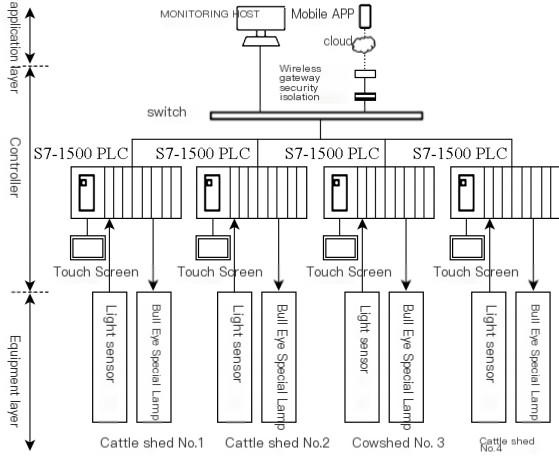
Tab.1 Parameters of special lamps for lactation cattle shed

3.3.2 Light Sensor Selection
Given the extensive area of the cattle shed, this study chose the RS-GZ-N01-2 light sensor from Shandong Renke Measurement and Control Technology Co., Ltd. to accurately measure the ground light intensity. This sensor has a measurement accuracy of ±7%. It converts the measured light intensity into a 4-20 mA standard signal, which is then transmitted to the PLC's analog channel via a communication cable. The sensor is installed in the feeding aisle at a height of 60 to 80 cm from the ground, which aligns with the height of the cows' eyes during feeding.
3.3.3 PLC Controller Selection
PLC control technology has proven effective in agriculture, fulfilling the reliability and real-time requirements for lighting control systems. After analysis, the Siemens S7-1500 PLC controller was chosen for the intelligent lighting system. It includes an Ethernet communication module, an analog input module, an analog output module, a switch input module, and a switch output module. The analog input module receives the 4-20 mA signal from the light sensor, while the analog output module sends brightness adjustment commands to the cattle shed lights. The switch output module controls the lights' on/off status, and the switch input module gathers operational status information from both the cattle shed lights and the light sensor. Additionally, the Ethernet communication module facilitates communication between the local PLC, touch screen, and background switch, enabling both local and remote control of the cattle shed lighting.
3.4 Control Circuit Design
3.4.1 Intelligent Lighting System Control Circuit
To achieve consistent lighting in the feeding aisle of the cattle shed, 16 specialized lights for cow eyes are installed in each cattle shed, all connected in parallel and controlled by a single AC contactor. To maintain voltage quality when all lights are on, the first and third cattle sheds use L1-N wiring, the second cattle shed uses L2-N wiring, and the fourth cattle shed uses L3-N wiring. The design of the intelligent lighting system control circuit is illustrated in Figure 2.
Fig.2 Light system control circuit
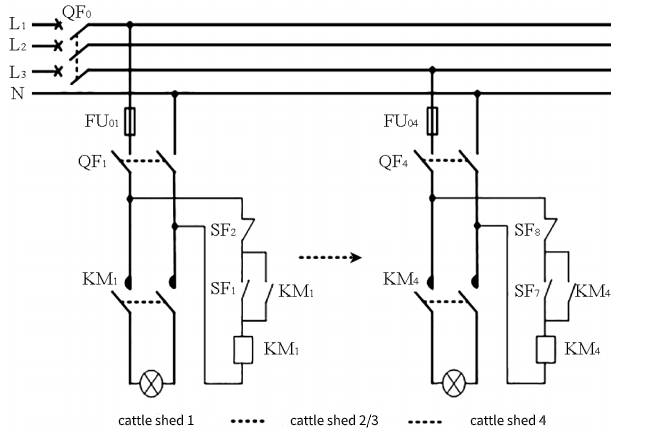
3.4.2 Allocation of Control Signals for Intelligent Lighting System
To enable the PLC control unit to gather real-time lighting data from each cattle shed and oversee the lights' operational status, the intensity of the specialized lights for cows' eyes can be controlled intelligently. This includes switch input signals for light activation, deactivation, light failure, and light sensor failure, along with an analog input signal for illumination. Additionally, there are switch output commands for turning the lights on and off, as well as analog output commands for adjusting illumination. The I/O configuration for the lighting system is presented in Table 2.
Tab.2 Light system I / O distribution
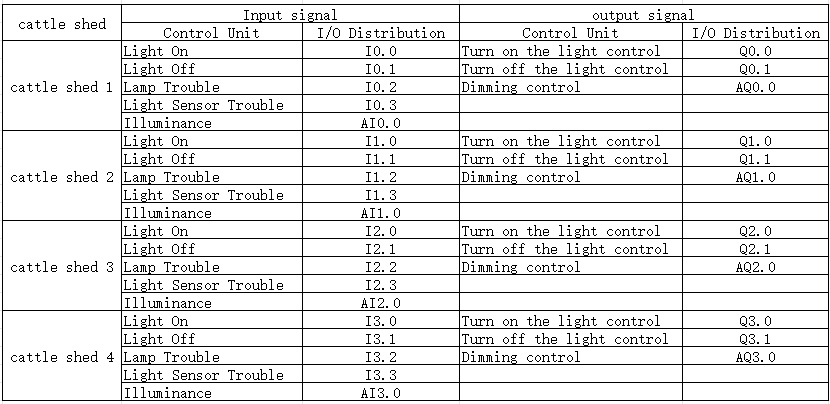
3.4.3 External Wiring Design for PLC
To facilitate communication between the PLC control unit, the light sensor, and the specialized lamp for cow eyes, the external wiring design for the PLC control unit in each cattle shed is illustrated in Figure 3.
Fig.3 PLC external wiring
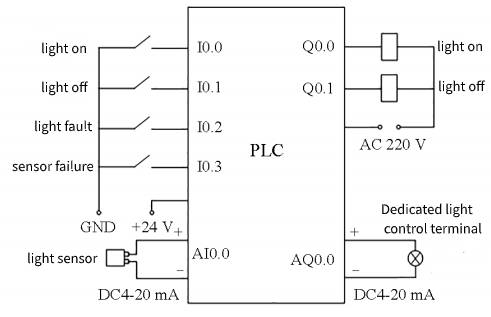
3.5 cattle shed Lighting System Control Modes
The lighting system for the cattle shed operates in two modes: manual and automatic. Staff can manually adjust the lighting using a touch screen, a background monitoring host, or a mobile app, allowing them to monitor the lighting status and environmental conditions of each cattle shed in real time through the user interface. In automatic mode, the PLC system manages the lighting by automatically turning it on and off and adjusting the brightness based on pre-defined cycles, light intensity, and other factors. The control process for the cattle shed lighting system is illustrated in Figure 4.
Fig.4 Illumination system control process
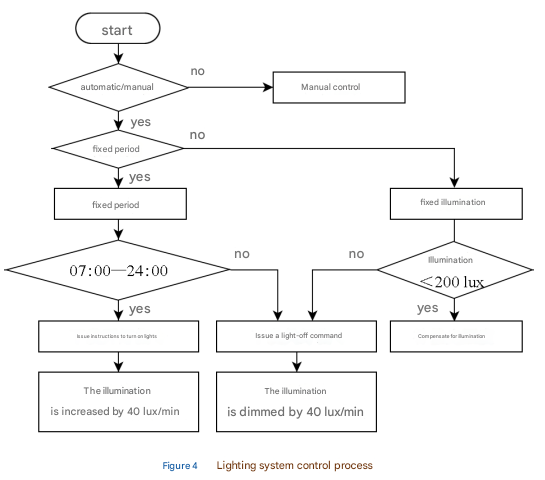
The aim of fixed light cycle control is to enhance the hormonal response in cows by alternating between periods of light and darkness, thereby optimizing their production performance. Based on the feeding and resting habits of dairy cows, the light cycle is categorized into a light phase lasting 15 to 18 hours and a dark phase lasting 6 to 9 hours. When the automatic fixed light cycle mode is activated, the system will turn on the lights in the cattle shed daily from 07:00 to 24:00 and switch them off at other times to ensure adequate lighting for the cows.
The goal of fixed light illumination control is to provide dairy cows with a comfortable light intensity that boosts their appetite, leading to increased roughage intake and milk production during the night. When this control mode is implemented, the system automatically monitors the current light intensity using a sensor, processes this data against pre-set control parameters in the PLC program, and sends adjustment commands to the specialized cow eye lamps to maintain the desired light intensity in the cattle shed. The closed-loop adjustment mechanism for fixed light illumination is illustrated in Figure 5.
Fig.5 Closed-loop regulation principle of illumination intensity

3.6 Design of Human-Computer Interaction Interfaces
To enhance the informatization of dairy farming, facilitate environmental monitoring, enable remote management of the dairy farm, and effectively address the lighting management needs of the cattle shed, both manual and automatic control modes are implemented. In manual mode, personnel are responsible for manually switching the lights on and off in each cattle shed and entering control parameters based on the required lighting brightness adjustments. The manual control interface for the lighting system is illustrated in Figure 6.
Fig.6 Manual control of illumination interface
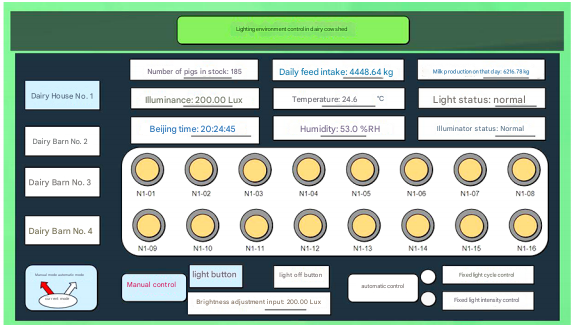
In automatic control mode, personnel have the option to select either fixed light cycle control or fixed light intensity control. The user interface for the automatic lighting system control is illustrated in Figure 7.
Fig.7 Automatic control of illumination interface

4. cattle shed Lighting Control Parameter Configuration
4.1 Description of the Configuration Method
The primary distinction between the cattle shed lighting system and industrial lighting control systems is found in the configuration of control parameters and the assessment of lighting effects. The process for setting parameters in industrial lighting systems is brief, with rapid control response and a more straightforward evaluation of lighting comfort. In contrast, the parameter setting and optimization cycle for cattle shed lighting systems is lengthy and complex, making the industrial method unsuitable. Adjustments to the cattle shed lighting parameters must be made from the cow's perspective. Changes in lighting parameters can slowly influence the cow's production performance and health, requiring time before noticeable effects on feed intake or milk production occur. Therefore, this study suggests using milk production as a key evaluation metric, employing control tests and data analysis to fine-tune the lighting duration and intensity of the intelligent lighting system in the cattle shed, ultimately selecting the most effective lighting duration and intensity parameters for the control system.
4.2 Configuration of Intelligent Lighting System Control Parameters
A sample of 50 healthy lactating cows was selected from a dairy farm in Yunnan Province, with an average milk production of (24.6±2.8) kg/week, an average parity of (2.2±0.9) times, and an average body size of (143±69) cm.
A control group of five cows was randomly chosen and housed in a traditional cow barn with natural lighting. Meanwhile, 45 cows were split into 9 groups to examine how varying light durations and intensities affected milk production. Each experimental factor was tested at three levels: light durations of 13. 15. and 18 hours, and light intensities of 150. 200. and 250 lux. Throughout the entire experiment, all cows received the same composition of concentrate, roughage, and other forage components. The test parameters and results are detailed in Table 3.
Tab.3 Dairy cow house light test data

4.3 Test Results and Parameter Determination
The production performance of dairy cows is influenced by several key factors, including genetics, environment, and physiology. To enhance the production performance of dairy cows, it is essential to thoroughly understand these influencing factors. As indicated in Table 3. the weekly average increase in milk production varies among different groups, suggesting that the duration and intensity of light in the cow housing have differing impacts on milk production. The SY-5 group exhibited the highest weekly average increase in milk production, leading to a preliminary conclusion that a lighting duration of 15 hours and an intensity of 200 lux are most beneficial for dairy cow production performance. To further investigate the effects of lighting duration and intensity on milk production, Table 3 was reorganized, calculated, and analyzed, with the findings presented in Table 4.
Tab.4 Comparative analysis of test results

Table 4 reveals that the highest average increase in milk production from the three tests with a lighting duration of 15 hours was 25.44 kg, suggesting that this lighting duration had a more significant impact on dairy cows' milk production compared to 13 and 18 hours. Additionally, the peak average increase in milk production associated with a light intensity of 200 lux was 20.36 kg, indicating that this intensity was more effective than 150 and 250 lux. The variation in milk production due to lighting duration (13.43 kg) is considerably greater than that due to light intensity (2.79 kg), highlighting that lighting duration is the primary factor influencing milk production in dairy cows. The findings suggest that a combination of 15 hours of lighting and 200 lux intensity is optimal for dairy farms.
This research evaluates the weekly average increase in milk production of the experimental group of dairy cows, identifying the 15-hour lighting duration and 200 lux intensity from group SY-5 as the ideal parameters for the intelligent lighting control system. The approach of adjusting lighting duration and intensity through controlled tests proves effective for enhancing total milk production on the dairy farm in the later stages of the experiment and can be applied to regulate other breeding environment parameters.
Conventional dairy farms typically design lighting systems for cow barns based on human photosensitivity and work requirements, often neglecting the unique photosensitivity of cows and failing to consider their comfort in lighting design and control. This study examines the lighting management and control needs of large-scale dairy farms in Yunnan Province, proposing an intelligent lighting system solution that includes system architecture, hardware components, control methods, human-computer interaction interfaces, and control parameter settings based on the Siemens S7-1500 PLC control framework. This provides a technical reference for the intelligent management of breeding environments in large-scale dairy farms in Yunnan Province and aims to inspire design improvements for the lighting conditions in other large-scale dairy operations.
5. best led lights for cattle sheds


6. Related Solution & Science
7. Related Blog
Swine Lighting System Standards: best Light Fixtures for Swine Building
Led Swine Lighting: The Application of Light Fixtures for Swine Barns
Pig Farms Lighting Design: Best Light for Pig House
8. Contact Ceramiclite
